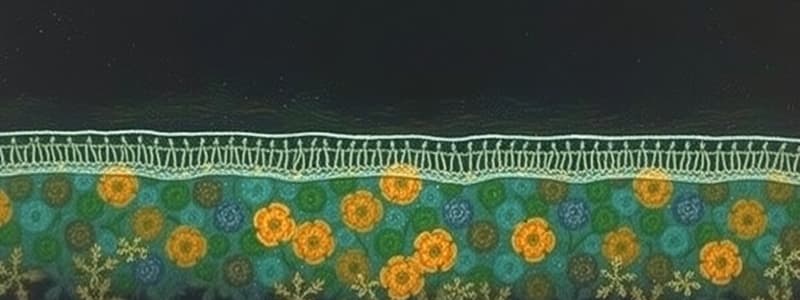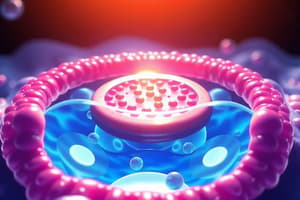Podcast
Questions and Answers
What is the primary function of cell membranes regarding structural integrity?
What is the primary function of cell membranes regarding structural integrity?
- To facilitate enzymatic reactions.
- To maintain the cell's structural integrity. (correct)
- To maximize energy production.
- To allow rapid diffusion of all substances.
How would you describe a membrane that restricts the passage of all substances?
How would you describe a membrane that restricts the passage of all substances?
- Selectively permeable.
- Semi-permeable.
- Impermeable. (correct)
- Freely permeable.
What mechanism allows certain polar molecules to cross the cell membrane?
What mechanism allows certain polar molecules to cross the cell membrane?
- Random diffusion.
- Osmosis.
- Transport proteins or channels. (correct)
- Active transport.
What describes the passive transport mechanism in cell membranes?
What describes the passive transport mechanism in cell membranes?
What is the role of enzymes in the plasma membrane?
What is the role of enzymes in the plasma membrane?
Which type of molecules can easily diffuse across the phospholipid bilayer?
Which type of molecules can easily diffuse across the phospholipid bilayer?
What happens to the rate of net diffusion when concentrations reach equilibrium?
What happens to the rate of net diffusion when concentrations reach equilibrium?
Which mechanism requires no ATP for movement across the membrane?
Which mechanism requires no ATP for movement across the membrane?
At what distance does oxygen diffusion take approximately 1.7 seconds?
At what distance does oxygen diffusion take approximately 1.7 seconds?
What characterizes facilitated diffusion compared to simple diffusion?
What characterizes facilitated diffusion compared to simple diffusion?
Which scenario indicates a substance diffusing from greater to lesser concentration?
Which scenario indicates a substance diffusing from greater to lesser concentration?
What is the correct relationship between diffusion time and distance for proteins compared to glucose?
What is the correct relationship between diffusion time and distance for proteins compared to glucose?
What is the primary function of carrier proteins in membrane transport?
What is the primary function of carrier proteins in membrane transport?
How does facilitated diffusion differ from simple diffusion?
How does facilitated diffusion differ from simple diffusion?
What distinguishes ligand-gated channels from other types of ion channels?
What distinguishes ligand-gated channels from other types of ion channels?
What type of channel is always open regardless of external conditions?
What type of channel is always open regardless of external conditions?
What role does phosphorylation play in the function of phosphorylation-gated channels?
What role does phosphorylation play in the function of phosphorylation-gated channels?
Which factor primarily influences the selectivity of ion channels?
Which factor primarily influences the selectivity of ion channels?
How does acute regulation of facilitated diffusion differ from chronic regulation?
How does acute regulation of facilitated diffusion differ from chronic regulation?
How do electrical forces contribute to ion transport across the membrane?
How do electrical forces contribute to ion transport across the membrane?
What is the primary function of the pump described in the content?
What is the primary function of the pump described in the content?
What characterizes secondary active transport?
What characterizes secondary active transport?
Which of the following best describes exocytosis?
Which of the following best describes exocytosis?
What distinguishes phagocytosis from pinocytosis?
What distinguishes phagocytosis from pinocytosis?
What role do kinesins and dyneins play in vesicular trafficking?
What role do kinesins and dyneins play in vesicular trafficking?
What is the primary function of K+ leakage channels in a cell?
What is the primary function of K+ leakage channels in a cell?
What outcome occurs when the electrical gradient opposing K+ leakage balances the concentration gradient favoring K+ leakage?
What outcome occurs when the electrical gradient opposing K+ leakage balances the concentration gradient favoring K+ leakage?
Which statement accurately describes the Na+/K+ pump?
Which statement accurately describes the Na+/K+ pump?
What creates the cell membrane potential in an excitable cell?
What creates the cell membrane potential in an excitable cell?
How is the net movement of ions across the membrane determined?
How is the net movement of ions across the membrane determined?
Which of the following ions is primarily concentrated outside the cell?
Which of the following ions is primarily concentrated outside the cell?
What is the effect of the intracellular negativity on K+ ion movement?
What is the effect of the intracellular negativity on K+ ion movement?
What type of transport is the Na+/K+ pump an example of?
What type of transport is the Na+/K+ pump an example of?
Flashcards are hidden until you start studying
Study Notes
Cell Membranes
- Cell membranes maintain the structural integrity of the cell and define its boundaries.
- They act as selective barriers, regulating the transport of substances in and out of the cell.
- They control the cell's internal environment and contain enzymes and receptors.
- Comprised of about 50% protein and 50 lipid molecules per protein.
Membrane Permeability
- The permeability of the cell membrane determines which substances can enter or leave the cell.
- Freely permeable membranes allow any substance to cross.
- Impermeable membranes prevent any substance from crossing.
- Cell membranes are selectively permeable, allowing the passage of some materials while restricting others.
- The lipid bilayer structure generally restricts the passage of polar molecules.
- Cells can insert specific transport proteins or channels into the membrane to permit the passage of certain polar molecules.
- Variations in the organization and identity of membrane lipids and proteins determine the permeabilities of different cells and organelles.
Membrane Transport Mechanisms
- Passive transport does not require ATP.
- Active transport requires ATP.
Diffusion
- All molecules exhibit random thermal motion, resulting in a random walk.
- Diffusion is only effective for transport over short distances.
- The rate of diffusion depends on the size of the molecule.
- Net diffusion occurs from an area of greater concentration to an area of lesser concentration.
- Net diffusion stops when concentrations reach equilibrium.
Net Diffusion of Molecules Across a Cell Membrane
- The rate of net diffusion is described by Fick's Law.
- Factors influencing diffusion rate:
- Diffusion coefficient (dependent on molecule size)
- Surface area of the membrane
- Concentration difference across the membrane
- Thickness of the membrane
Simple Diffusion
- Water, O2, CO2, and lipid-soluble molecules like fatty acids and steroids can easily diffuse across the phospholipid bilayer.
Facilitated Diffusion
- Hydrophilic molecules (K+, Na+, Ca2+, amino acids, monosaccharides) cannot pass directly through the phospholipid bilayer.
- They require protein channels or carrier proteins to cross the membrane.
- Facilitated diffusion occurs when hydrophilic molecules are aided through the membrane down their concentration gradient.
- Important metabolites are often acted upon immediately upon entering the cell, keeping intracellular concentration low and facilitating further uptake.
Carrier Proteins
- Carrier proteins have binding sites for the transported molecule.
- Binding causes a conformational change in the protein, releasing the molecule on the other side of the membrane.
Channels
- Channels form permanent water-filled pores spanning the membrane.
- They have a selectivity filter that allows only specific ions to pass through.
- Selectivity is based on size and charge of the ion.
Classification of Channels by Channel Gating
- Constitutively open (or passive) channels: almost always open (e.g., water channels, K+ leak channels, Na+ leak channels).
- Ligand-gated channels: open upon binding of a specific molecule (the ligand).
- Phosphorylation-gated channels: open or closed depending on the phosphorylation state of the channel protein.
- Voltage-gated channels: open or closed in response to changes in membrane potential.
- Mechanically-gated channels: open or closed in response to stretching or pulling forces (found in sensory receptors).
Electrical Forces and Membrane Potential
- Cells use energy to concentrate K+ inside the cell and Na+ outside the cell.
- K+ leakage channels allow K+ to leak out of the cell down its concentration gradient.
- This leakage creates a separation of charges across the membrane, resulting in the cell membrane potential.
- All cells have a membrane potential.
- The electrical gradient opposes the movement of K+ ions out of the cell, balancing the chemical gradient at equilibrium.
- Ions diffuse according to their electrochemical gradient, which combines the concentration gradient and the electrical gradient.
Active Transport
- Active transport pumps molecules against their electrochemical gradient using energy.
- Primary active transporters (or pumps): directly use ATP to transport molecules against their gradients.
- Secondary active transport: utilizes the energy stored in an electrochemical gradient (like the Na+ gradient) to move other molecules against their electrochemical gradients. Transport of the two molecules is coupled.
Example: Na+/K+ Pump
- Uses the energy released by ATP hydrolysis to move K+ and Na+ across the plasma membrane against their electrochemical gradients.
- Maintains high intracellular K+ concentration and low intracellular Na+ concentration.
- For every ATP, 3 Na+ ions are transported out of the cell and 2 K+ ions are transported in.
Example: Transepithelial Transport of Glucose in the Intestine
- Uses secondary active transport with the Na+ gradient to move glucose across the intestinal epithelium.
Vesicular Transport (or Bulk Transport)
- Exocytosis: moves substances out of the cell.
- Endocytosis: moves substances into the cell.
- Transcytosis: moves substances across a cell layer.
- Substance (or Vesicular) Trafficking: moves substances from one area of the cell to another.
- All require energy.
Vesicular Transport: Exocytosis
- Intracellular vesicles fuse with the plasma membrane, spilling the contents of the vesicle out of the cell.
- Requires Ca2+.
Vesicular Transport: Endocytosis
- Infoldings in the plasma membrane import materials into the cell.
- Types of endocytosis:
- Phagocytosis: cell eating (engulfing large particles).
- Pinocytosis: cell drinking (engulfing fluid).
- Receptor-mediated endocytosis: specific molecules bind to receptors on the plasma membrane, triggering endocytosis.
Phagocytosis
- Uses pseudopods to engulf large particles.
- Important for immune cells to engulf bacteria and debris.
Vesicular Trafficking
- Motor molecules called kinesins and dyneins carry loaded vesicles along microtubules.
- This transport allows for efficient movement of substances within the cell.
Studying That Suits You
Use AI to generate personalized quizzes and flashcards to suit your learning preferences.




